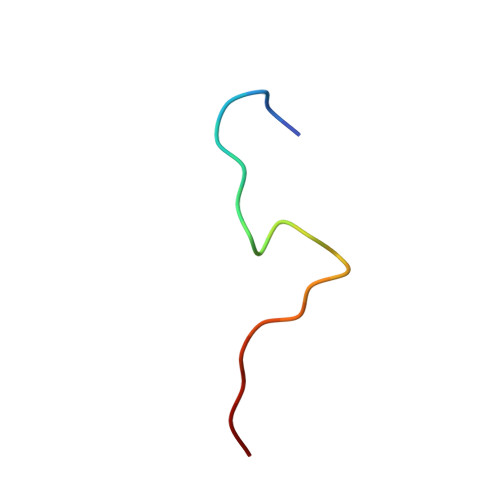Cyclophilin A allows the allosteric regulation of a structural motif in the disordered domain 2 of NS5A and thereby fine-tunes HCV RNA replication.
Dujardin, M., Madan, V., Gandhi, N.S., Cantrelle, F.X., Launay, H., Huvent, I., Bartenschlager, R., Lippens, G., Hanoulle, X.(2019) J Biological Chem 294: 13171-13185
- PubMed: 31315928
- DOI: https://doi.org/10.1074/jbc.RA119.009537
- Primary Citation of Related Structures:
6HT4 - PubMed Abstract:
Implicated in numerous human diseases, intrinsically disordered proteins (IDPs) are dynamic ensembles of interconverting conformers that often contain many proline residues. Whether and how proline conformation regulates the functional aspects of IDPs remains an open question, however. Here, we studied the disordered domain 2 of nonstructural protein 5A (NS5A-D2) of hepatitis C virus (HCV). NS5A-D2 comprises a short structural motif (PW-turn) embedded in a proline-rich sequence, whose interaction with the human prolyl isomerase cyclophilin A (CypA) is essential for viral RNA replication. Using NMR, we show here that the PW-turn motif exists in a conformational equilibrium between folded and disordered states. We found that the fraction of conformers in the NS5A-D2 ensemble that adopt the structured motif is allosterically modulated both by the cis / trans isomerization of the surrounding prolines that are CypA substrates and by substitutions conferring resistance to cyclophilin inhibitor. Moreover, we noted that this fraction is directly correlated with HCV RNA replication efficiency. We conclude that CypA can fine-tune the dynamic ensemble of the disordered NS5A-D2, thereby regulating viral RNA replication efficiency.
- University of Lille, CNRS, UMR 8576, UGSF-Unité de Glycobiologie Structurale et Fonctionnelle, F-59000 Lille, France.
Organizational Affiliation:
















